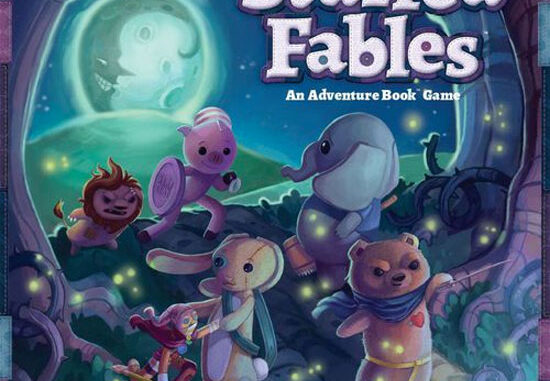
While searching for some kind of gateway RPG for my son we came across Stuff Fables from Plaid Hat Games. We wanted something to lay out the basic concepts of playing in an RPG. So how did Stuffed Fables work out?
Gameplay- B-
The basic structure has each player playing a different stuffed animal character, each with their own special abilities. The game has seven different stories that you play through as your ‘stuffies’ go on adventures while their little girl sleeps. The game does a fairly good job of expanding the choices as you progress. In the first adventure, it is very much on rails. You have one clear objective and very little choice how to do it. This works well for teaching kids rules and easing into a game more complicated than a straightforward board game. By the time you get to the final few adventures, you actually have choices about where you go next rather than following the story one page at a time in order.
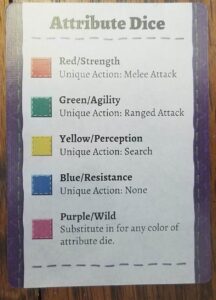 Mechanically, on your turn you draw five dice from a bag and then decide how to use them. There are seven different colors and each color allows you to do different things. This keeps turns random, as you never know what you can do until you draw. This can lead to some frustration, as more often than it should, you have a turn where you can literally do nothing useful because you don’t have the right color dice.
Mechanically, on your turn you draw five dice from a bag and then decide how to use them. There are seven different colors and each color allows you to do different things. This keeps turns random, as you never know what you can do until you draw. This can lead to some frustration, as more often than it should, you have a turn where you can literally do nothing useful because you don’t have the right color dice.
Fortunately, you can use any dice to move so uselessness doesn’t happen too frequently. On most maps, there are locations to move to and explore. Moving around to designated spots fill in new things about the story and trigger challenges to overcome on the map. The skill actions are a simple enough concept to understand: beat a certain number, usually with a certain color dice. The game builds up the RPG flavor with gear you can acquire that gives boosts. This, in conjunction with each stuffy’s abilities, means kids start to learn character specialization.
Some of the map encounters involve meeting random denizens of the ‘Lost,’ the zone you are traveling in full of lost toys. When you encounter these, you’ll be given a choice to make and might get a benefit or have something bad happen depending on the choice. This is good for working in the RPG concepts of exploring and facing NPCs/traps while not giving kids to much of an open ended world. Unfortunately, the game expects some things that don’t mesh with game play a lot of times.
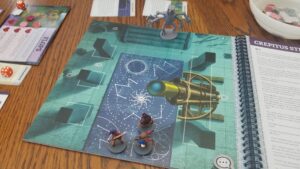 For example, when you draw one of these Lost cards, you can be presented with a choice of giving two different resources. But sometimes you don’t have either of those resources. Or you only have one but you don’t want to give it up. You could just choose not to give it up and that’s a choice on some cards. But not all. There’s no clear rule of what to do when you are given a choice between two things you can’t, or don’t want to, do. This led to my stuffy running around without a weapon for awhile (which meant he could not attack). It made things interesting at least.
For example, when you draw one of these Lost cards, you can be presented with a choice of giving two different resources. But sometimes you don’t have either of those resources. Or you only have one but you don’t want to give it up. You could just choose not to give it up and that’s a choice on some cards. But not all. There’s no clear rule of what to do when you are given a choice between two things you can’t, or don’t want to, do. This led to my stuffy running around without a weapon for awhile (which meant he could not attack). It made things interesting at least.
This assumption in the cards gets even weirder on some maps. At the start of each adventure, you start with fresh gear and resources. Nothing carries over. But on more than one starting map, there will be things that require you to trade something that you haven’t had a chance to acquire yet. In later adventures, you can go back to places but in the early ones your path is linear.
The game’s combat system swings wildly between overwhelming and too easy. We had one map, right at the beginning, where the bad guys spawned and killed all of us in their first activation. This happens because they do quite a bit of damage, often times more than you have in health. Now, you are playing stuffed animals and you are never killed, just deflated and can recover later, unless there’s a TPK. On another map, we were facing off against a boss. We killed it in a single character’s activation due to a lucky die draw and his abilities.
Production- B+
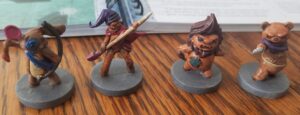 The game comes with a big book of adventures, lots of components and several bags of minis. Everything is sturdy and the minis aren’t flimsy plastic so they feel solid. They help bridge the connection with RPG’s as they are rife for painting and gaining personality. I didn’t bother with the bad guys but I did paint up our characters.
The game comes with a big book of adventures, lots of components and several bags of minis. Everything is sturdy and the minis aren’t flimsy plastic so they feel solid. They help bridge the connection with RPG’s as they are rife for painting and gaining personality. I didn’t bother with the bad guys but I did paint up our characters.
The box doesn’t provide great storage options but its functional enough. There are a lot of different types of cards but they at least have different backs so they’re easy enough to keep separate. We ended up having bags for each of the characters to store their items between sessions. This includes a character sheet with all their information and a turn card which outlines the what each die does, which is handy early on.
The biggest gripe with the components is the layout of the book. The rules aren’t easy to look up and leave a lot of ambiguity. That might be an us problem, as we’re all familiar with detail heavy games and my son in particular is a rules lawyer. So we easily find all the loopholes and unclear instructions, possibly overthinking things. On one particular map, you had to move through a factory and some of the machines cost you stuffing and there didn’t appear to be anyway to avoid this damage. There were enough of them that you basically lose almost your entire starting health to get to the end. So if you were less then topped up, you literally could not get through. We wracked our brains trying to figure out what we were missing in the text.
But more general, each page of the adventure book has some issues. The idea is you read the opening text, setting up the scenario and then go adventure. But the game has some trouble on the hand off between “on-rails” and “open-world”. You have to complete very specific actions to advance and sometimes the game doesn’t make that clear. You can move onto a space, trigger the advancement condition, have half the map untouched and feel like you’re missing some part of the story.
Theme- A
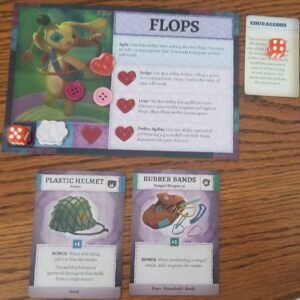 The game takes its theme of a little girl’s stuffed animals having adventures and runs with it. The art finds a line between cute and creepy. As you adventure, you encounter scary-ish bad guys and play the part of the hero. The meta story also plays out with the little girl growing up, from first night out of a crib to going to school.
The game takes its theme of a little girl’s stuffed animals having adventures and runs with it. The art finds a line between cute and creepy. As you adventure, you encounter scary-ish bad guys and play the part of the hero. The meta story also plays out with the little girl growing up, from first night out of a crib to going to school.
The items you can acquire are all things a stuffed animal might find and use as weapons or gear. Pencils, scissors, rubberbands are all in the arsenal. You don’t have health, but stuffing, which you can lose and acquire more of throughout the game.
The mini’s themselves match the artwork and convey their sense of childhood toys. The bad guys are all twisted versions of toys, à la Sid’s creations from Toy Story. There’s definite connections, almost to the point of a complete rip off with the Crawlies (baby doll heads on spider legs).
Expansions- TBD
None that I am aware of.
Conclusion- B
Despite some gripes about the game design and rules layout, my son had a lot of fun playing, which is all that really matters for a game like this. As a parent you might get bored or frustrated at times but its not as bad as many kids’ games and can help teach bigger game concepts to lead into deeper RPG’s
Now, if only HeroQuest was still in print…
